Your expert guide to what to do in Mérida, Spain
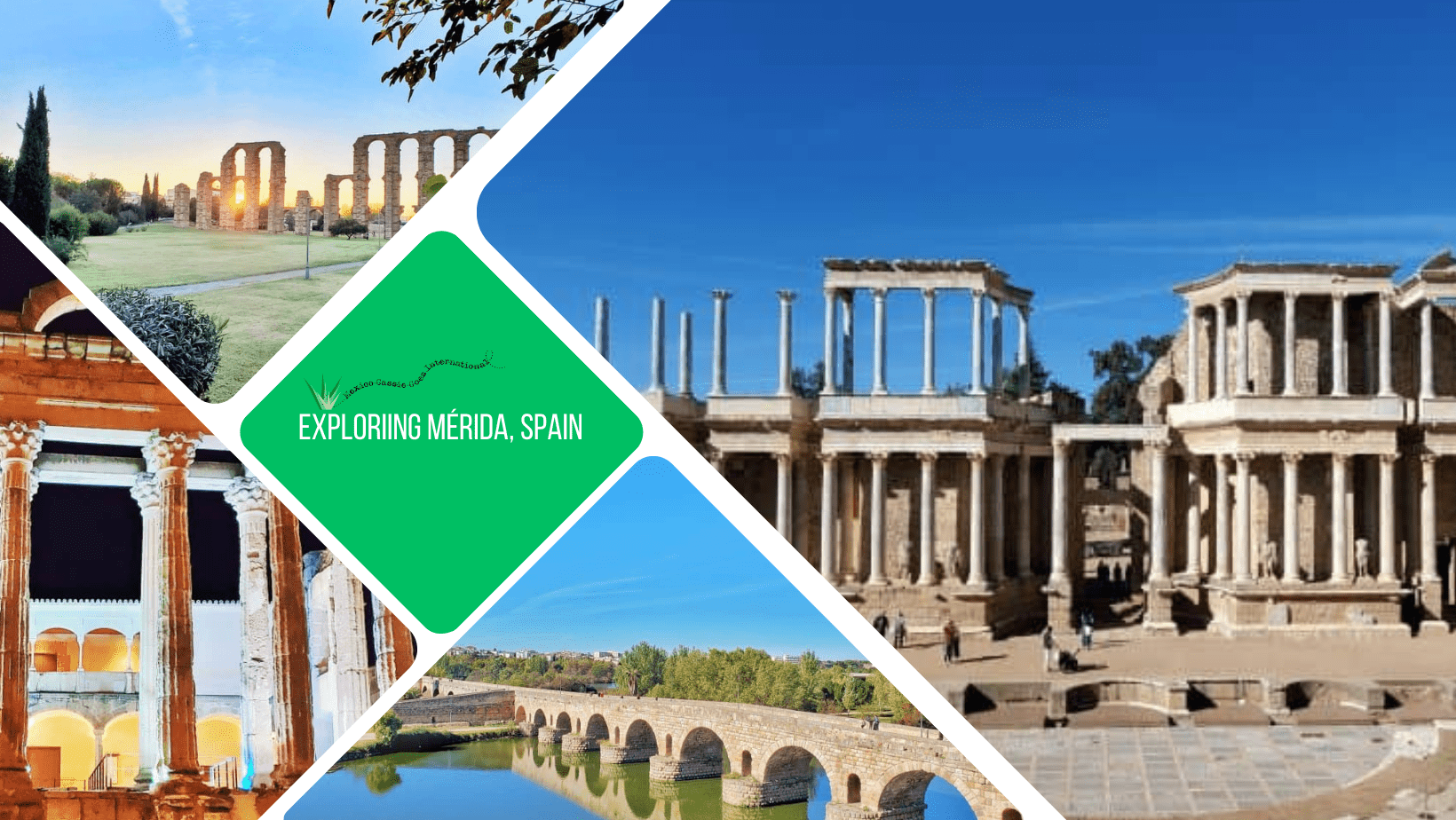
The original Mérida, the one in Spain, was founded by the Romans in the first century BCE and there’s still a surprising amount of ‘Roman Mérida’ to be seen.
If you’re wondering about what to do in Mérida, let me tell you that Mérida is a perfect two or three-day destination depending on how much walking you want to do in a day and how many Roman ruins you can manage.
We spent a long weekend checking it out and we found a lovely little city with a lot to recommend it.
There are affiliate links in this article. If you click and make a purchase I could make a small sum at zero cost to you. Thank you!
Mérida location highlights – why do people visit?
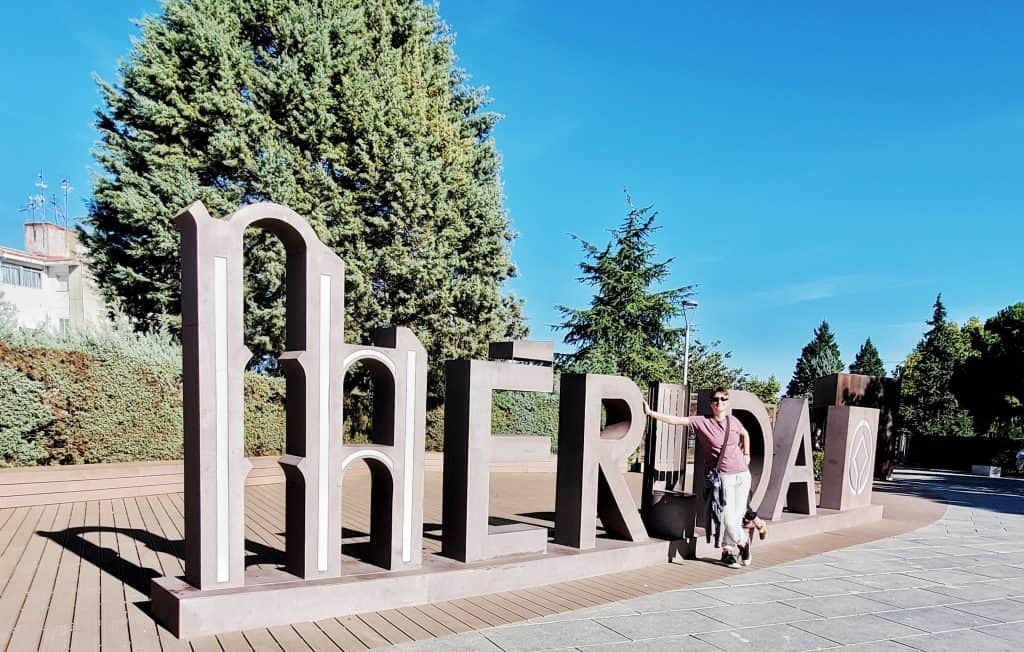
The archaeological ensemble of Mérida is a UNESCO World Heritage Site and one of the best preserved Roman sites in the whole of Spain. The archaeological sites here are numerous and are all beautifully restored and most informational signs are in English and Portuguese as well as Spanish.
Highlights include the biggest Roman house in Europe: Casa Mitrea, the amphitheatre and the theatre and the two aqueducts, an enormous Roman bridge and more.
The ruins are spread around the delightful, yet fairly compact city, leading people to wonder what remains buried under the modern city of Mérida. If you enjoy interesting places, beautiful buildings and Roman history, you can’t miss a trip to Mérida.
Where is Mérida
Mérida is the capital of Extremadura in southern Spain.
🛣 It’s a 2 – 2.5 hour drive from Seville, a 3hr30 drive from Madrid, 3hrs from Córdoba & 1 hr from Cáceres.
🌳 Extremadura is home to Monfragüe National Park, one of Spain’s most wonderful national parks and one of my personal favourite places to hike in Spain.
🚗 Check rental car options now
🚌 / 🚂 Check bus timetables on Omio / Busbud and check train timetables on Trainline
Where to stay in Mérida
🏨 Parador de Mérida – located in an 18th century convent building just a short walk from Mérida’s main attractions. The hotel has a peaceful courtyard garden and outdoor pool where guests can relax after exploring the city. Perfect for anyone who enjoys traditional elegance in their hotels.
→ Check availability and reserve now
🏨 AZZ Mérida Medea Hotel – this extremely reasonably priced 4 ⭐️ hotel is well located, has modern, spacious rooms and an enormous outdoor swimming pool. While not right down town, it’s just a 20 minute walk to the centre of the city (hence the fabulous price).
→ Check availability and reserve now
🏨 Hotel Ilunion Mérida Palace – located on the gorgeous Plaza de España, this restored 15th century palace has a wonderful rooftop terrace with a small pool and great views over the city.
→ Check availability and reserve now
🗺 Or, if none of these work for you, you can use my helpful interactive accommodation finder to choose something better suited to your needs.
History of Mérida
Mérida, founded in the first century BCE, with the name of Emerita Augusta, was the capital of the Roman province of Lusitania. Emperor Augustus founded it to serve as a retreat for veteran soldiers. It was apparently one of the most important cities in Roman Hispania.
After the fall of the Roman Empire, Mérida was taken over by the Visigoths and remained an important city under their rule until it was conquered by the Umayyad Caliphate. It remained under Muslim rule until it was taken by Alfonso IX of León in 1230.
The name Mérida can be traced from Emerita under the Romans to Māridah under the Muslims to the modern Mérida.
What to do in Mérida, Spain
🎟 We bought the “Entrada Conjunta” ticket and if you want to see most of what Mérida offers, I recommend you do the same. At the end of 2024 it costs €17 per adult. This price covers entry to all the sites listed below, which is an absolute bargain given the individual costs of these sites.
📲 Download a self-guided audio city tour to help you explore at your own pace.
👣 Take a free walking tour of Mérida
🚂 The tourist train can be picked up in front of the theatre/amphitheatre complex.
Teatro & Anfiteatro

The most visually impressive of all sites in Mérida. At this one site you have both the theatre and amphitheatre – people living in Roman Mérida could decide whether to go to watch a dramatic performance or something altogether more grizzly next door.
The theatre was constructed thanks to Agrippa, the son-in-law of Augustus. I learned here that the Romans weren’t super fond of theatre but still, the theatre had space for 6,000 spectators (of course, split by rank with women all the way at the back in the cheap seats, grrrrr ancient-Rome). We sat for a good while just basking in the beauty of the theatre – well, I did. The kids ran around the dark tunnels while I contemplated life and all the other things ancient history brings up). There is actually a classical theatre festival held here every year. I assume that women aren’t consigned to the shitty seats for this!
The Anfiteatro (Roman amphitheatre), where people gathered to watch gladiatorial contests that included wild animals fighting, was constructed around 8 BCE and could hold around 15 – 16 000 people (yup, well played Rome, more space for blood and guts than culture).
Alcazaba
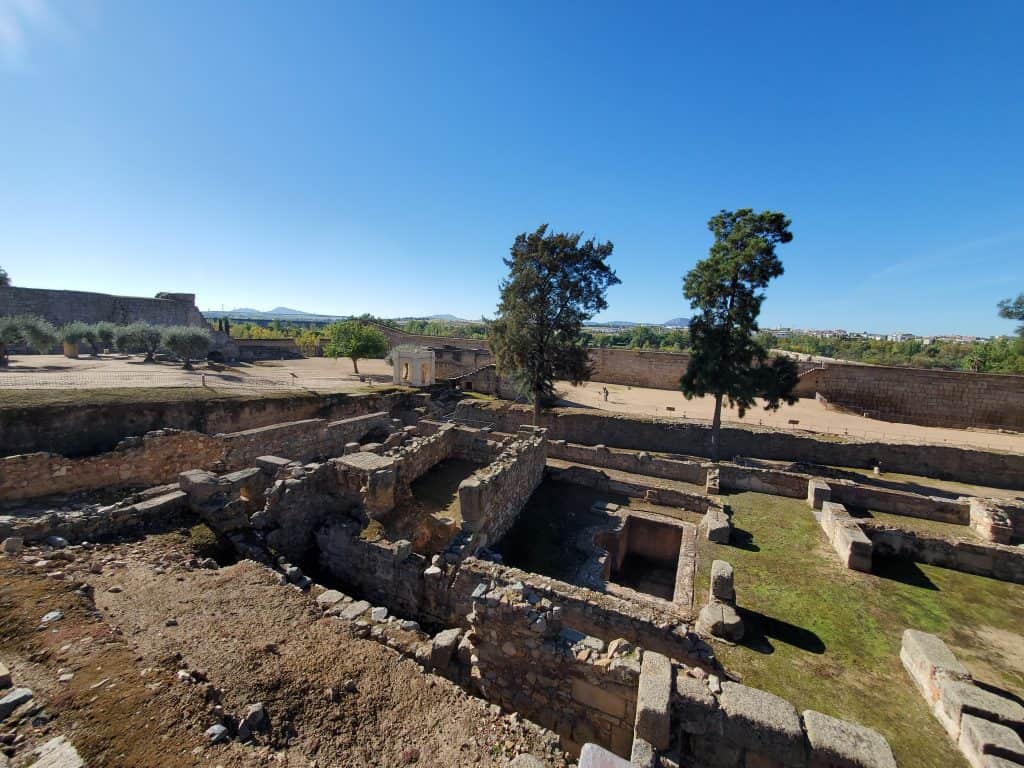
The Alcazaba is a large Islamic fort in the centre of the city. It isn’t often you can visit an Arab citadel that also has Visigoth and Roman ruins to be seen within – what am I saying? Of course it’s fairly normal in southern Spain that you can see all three side by side. Still, it’s kinda cool.
The fortress is younger than other sites in Mérida, having been built in 835 CE but it’s still the oldest Muslim fortress on the Iberian Peninsula. It was designed with three specific roles in mind: to serve as headquarters for the Umayyad administrators, as a residence for the local governor and to restrict/control access to the city via the Roman bridge and therefore provide safety to the Muslim population.
Inside the Alcazaba you’ll find the remains of a Roman road, a Roman house and a fascinating underground cistern that was built reusing both Roman and Visigoth architectural pieces. There are some good signs with explanations of everything in the site.
Casa del Mitreo / Mithraeum and Columbarios
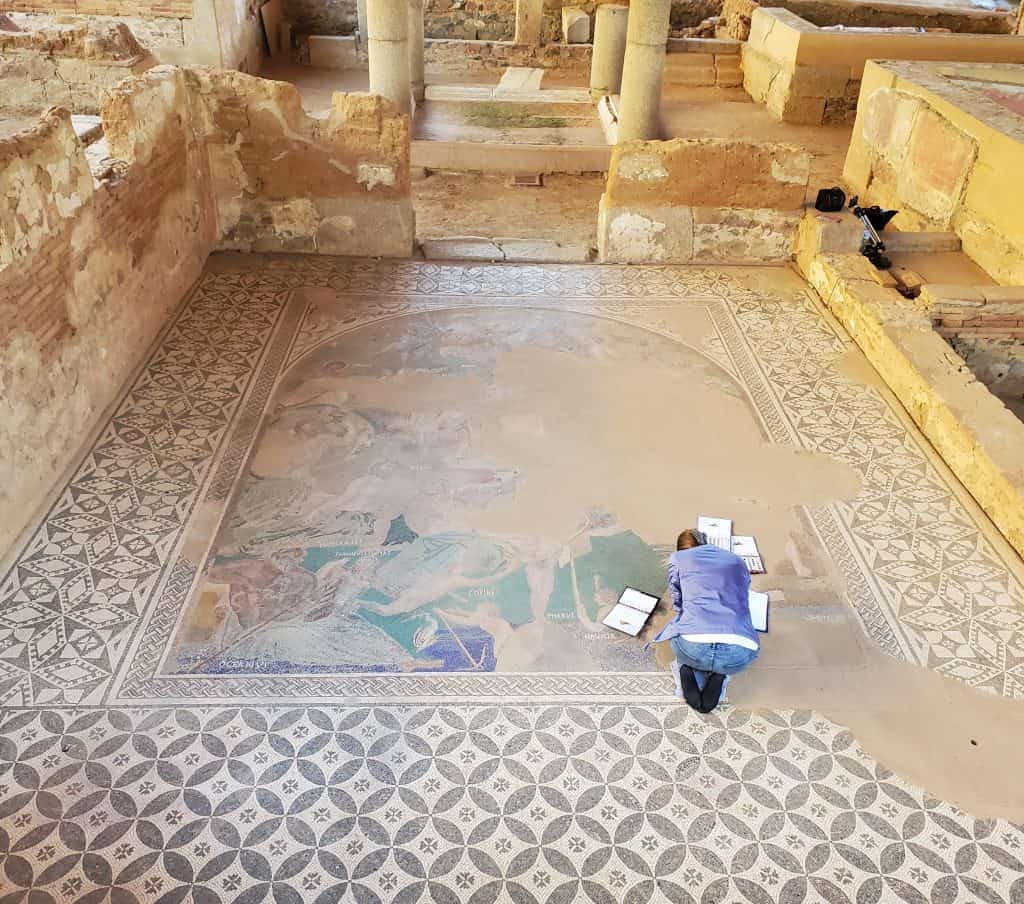
This site is apparently the biggest known Roman house in Europe. It was built sometime around the end of the first century of the common era just outside the Roman city walls. The highlight here is the first mosaic you come to, it is a representation of the cosmos revolving around the figure of Aeternitas (Eternity).
If you’re a fan of Roman ruins then you can’t miss Baelo Claudia, located on the beach near Tarifa in Andalucia or Conímbriga outside Porto, Portugal. They’re two of the best preserved Roman towns on the whole Iberian Peninsula. And just outside Sevilla is Italica, the first Roman city built in Spain.
Casa del Anfiteatro
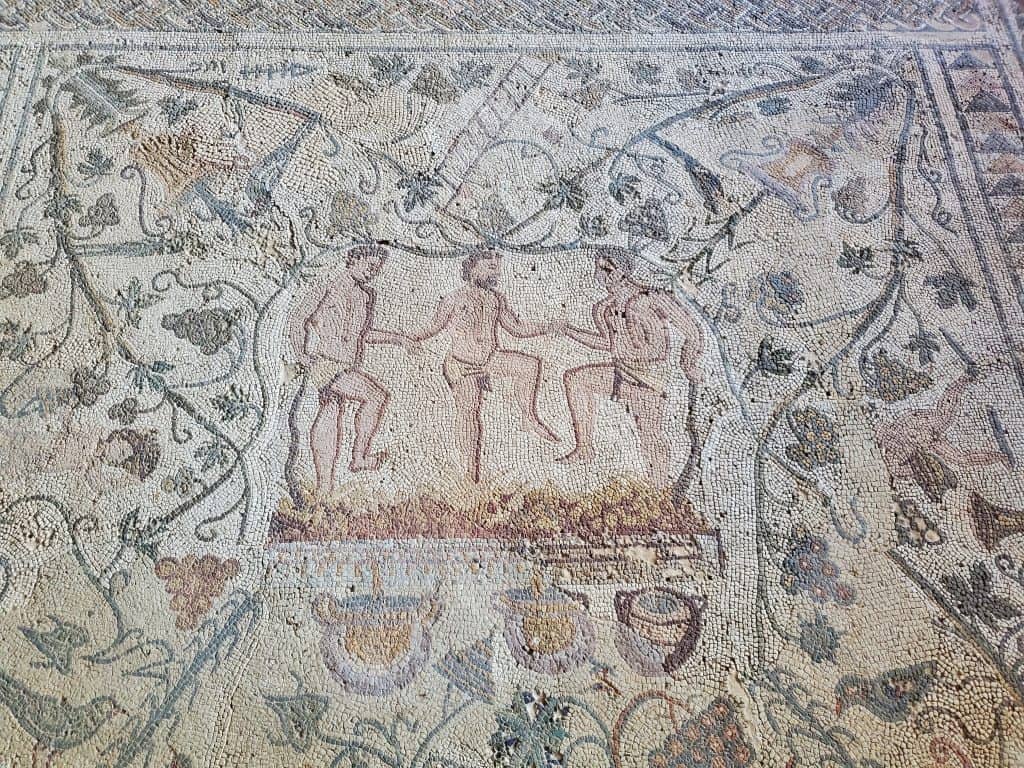
Next to the theatre and amphitheatre site is Casa Anfiteatro – we almost missed out on this treat of a Roman villa but thankfully decided to stick our heads in. The intricate mosaics here are great and it’s set up so visitors walk just above them, even with glass floors at one section. A touch screen full of explanations was joyfully jabbed at by the kids.
Circo (Roman Circus)
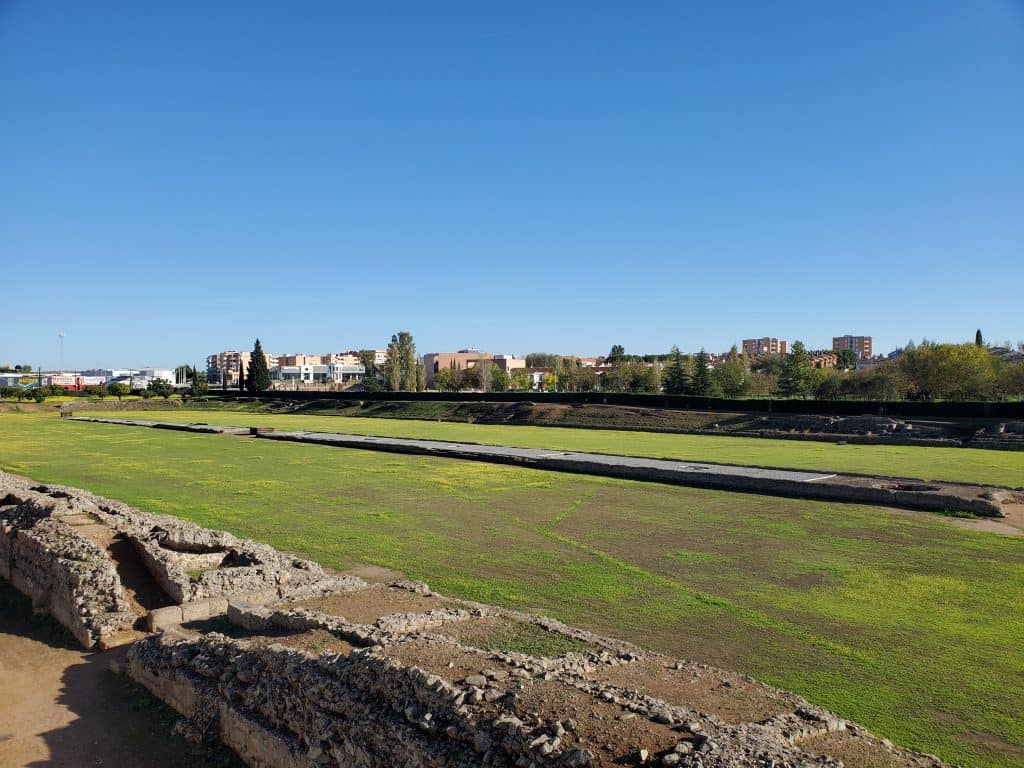
This site will have held up to 30,000 spectators (that’s half the current population of the city, by the way!).
Something of a walk from the other ruins in Mérida is the Roman circus (be sure to prepare any kids / clown fans lest they wind up disappointed that this isn’t a modern circus). What fascinated us the most here is that it hasn’t been turned into a giant park as the setting is extremely urban and it seems a waste to have this ticketed and behind a fence. However, since it is apparently one of the best preserved circuses of the entire Roman empire, we can kind of see why it is.
There is a small museum here too.
Templo de Diana
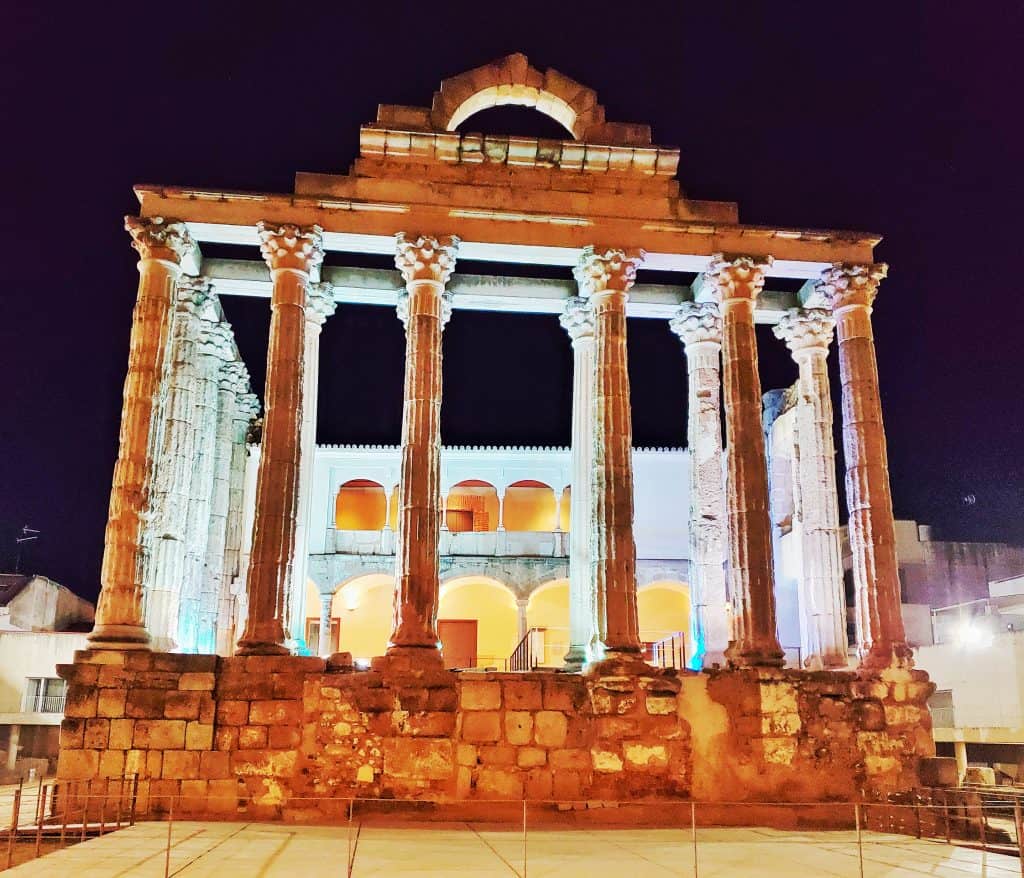
This Imperial Cult Temple is located right in the middle of modern Mérida. We stopped by at around 10 pm on Saturday night when it was nicely lit up but obviously closed. We returned on Sunday morning and discovered a small museum inside the house that’s within this Roman temple. A short video shown in the museum came as a relief to the kids who were very over Roman ruins by this point.
We did not see either the Cripta de la Basilica or the Zona Arqueologica Moreria due to lack of time. Both cost 6 Euros if visited as stand alone monuments but are included in the combined ticket.
What’s free to do in Mérida?
National Museum of Roman Art
By the amphitheatre complex is a really fabulous museum housing enormous mosaics, artefacts a superb three-floor collection of statues. We particularly enjoyed the exhibition about the discovery of the Roman theatre under a chickpea field in the early twentieth century!
Puente Romano (Roman Bridge)
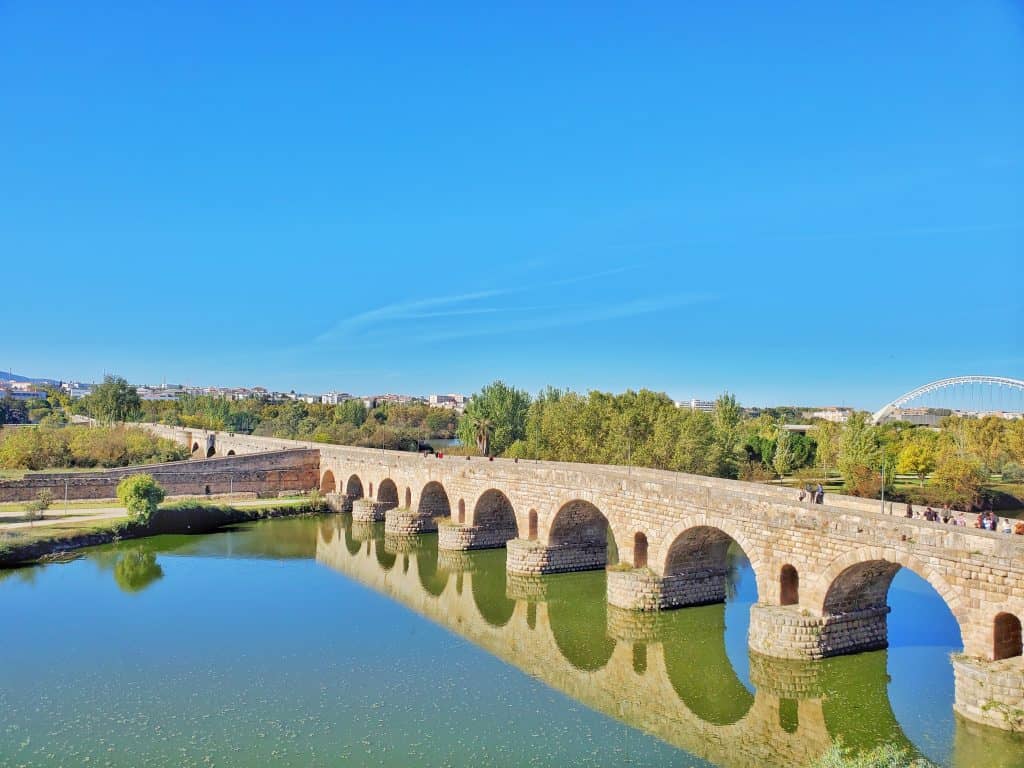
The Roman bridge over the River Guadiana is fun to walk over. If we’d had more time we’d have taken the exit in the middle down onto the island and had an explore down there. As it was, we were walking over the bridge to get to Carrefour to buy jackets for the kids because it was colder than we’d expected in early November.
The bridge is apparently one of the longest ever built by the Romans. It’s almost 800m long.
Acueducto de los Milagros
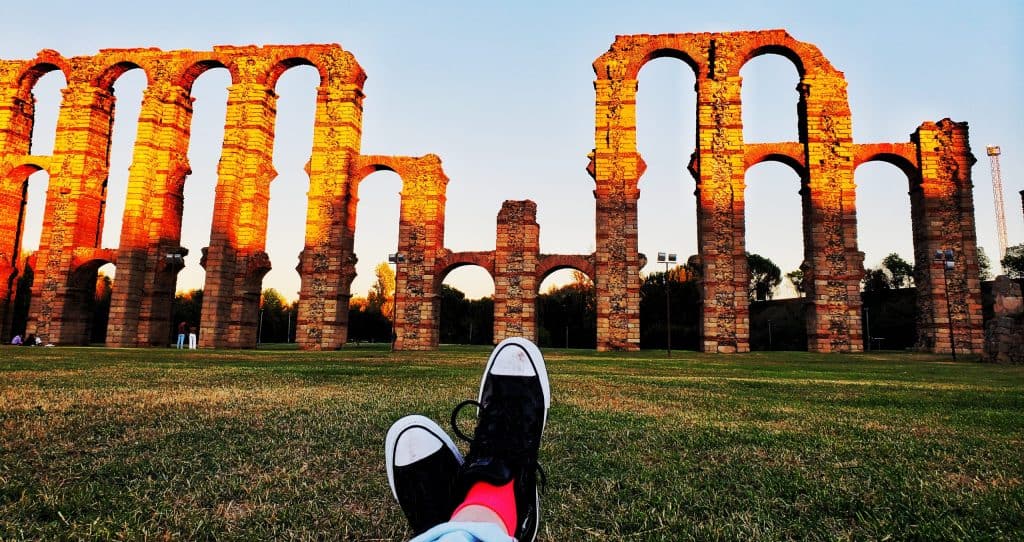
This aqueduct forms the shape of the sign for the modern city of Mérida and is really very impressive, standing at 27m tall. Apparently there is over 800m of it too. It’s located in the park over the river and is a popular place for locals and tourists to congregate. We were there at a chilly but magnificent dusk.
It was part of a hydraulic system bringing water to the city from the Proserpina Dam (also known as the Albuera Reservoir).
Of course, the biggest aqueduct in Spain is in Segovia, which is a four-hour drive from Mérida.
Alcalá de Guadaíra, some twenty minutes outside of Seville performed this duty for Seville under the Romans: water was carried from their natural springs via aqueduct into the city.
Plaza de España
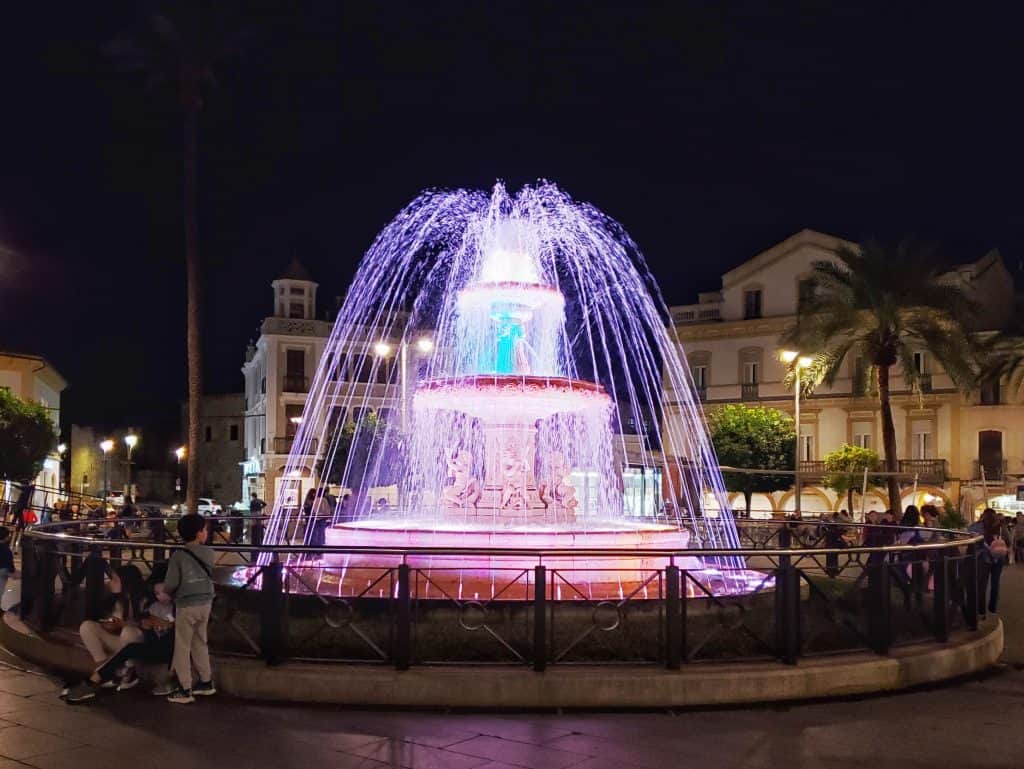
This lovely plaza is the centre of Mérida and it’s definitely somewhere to come for a drink or evening meal if you enjoy being a part of local life.
Smaller sites in Mérida
➕ Acueducto de San Lázaro – this aqueduct is about a kilometre long and was built in the first century of the common era. It’s somewhat less of an ‘attraction’ that its more impressive neighbour.
➕ Termas de San Lázaro – between the circus and the start of the aqueduct de San Lázaro are the remains of Roman thermal baths. There’s not much to see here.
➕ Arco de Trajano (Arch of Trajan) – this was once a monumental gate to a sacred space. Today, it’s an arch. The arch is 15m high and is pretty impressive even without the marble cladding it will have presumably had when built ).
➕ Portico de Foro Municipal de Augusta Emérita – yet more ruins just happily sitting in the middle of the city. Here you’ll see the remains of the city’s forum.
Sevilla
⭐️ What is Sevilla famous for? | ⭐️ How many days do you need in Seville? | ⭐️ Everything about the Seville airport bus
⭐️ 1 day in Seville | ⭐️ 3 days in Seville | ⭐️ 5 days in Seville | ⭐️ How to visit Seville in the summer | ⭐️ How to visit the Alcazar
⭐️ Best beaches from Seville | ⭐️ Day trips from Seville | ⭐️ Seville with kids | ⭐️ Seville with teenagers | ⭐️ How to see flamenco in Seville
Malaga
⭐️ 3 days in Malaga | ⭐️ 1 day in Malaga | ⭐️ Day trips from Malaga | ⭐️ 1 day in Ronda | ⭐️ 1 day in Ronda with kids | ⭐️ What to do in Antequera
Córdoba
⭐️ What to do in Córdoba | ⭐️ Planning your Córdoba day trip from Seville | ⭐️ Exploring Córdoba with kids | ⭐️ 1 day in Córdoba | ⭐️ Zuheros, the most beautiful village in Córdoba
Cádiz
⭐️ What to do in Cádiz province | ⭐️ How to spend 1 day in Cádiz city | ⭐️ What to do in Cádiz with kids | ⭐️ Exploring Tarifa | ⭐️ How to get to Tangier from Tarifa | ⭐️ Exploring Gibraltar
Huelva
⭐️ Is Huelva worth visiting? (YES) | ⭐️ What to see in the gorgeous Aracena
Granada
⭐️ Planning your Granada city break | ⭐️ Granada with kids | ⭐️ 2 days in Granada | ⭐️ How to explore Guadix and its cave houses
Almería
⭐️ Things to do in Almería City | ⭐️ What to do in Almería with kids | ⭐️ Is Almería worth visiting? | ⭐️ Figuring out the Almería beaches
➕ Valencia
⭐️ 1 day in Valencia | ⭐️ 2 days in Valencia | ⭐️ Museums in Valencia
⭐️ Day trips from Valencia | ⭐️ Valencia with kids
➕ Madrid
⭐️ Why should you visit Madrid | ⭐️ Segovia, a perfect day trip from Madrid

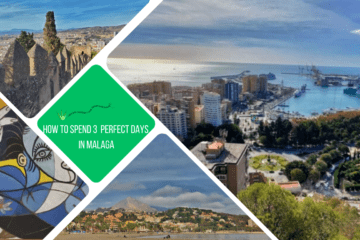
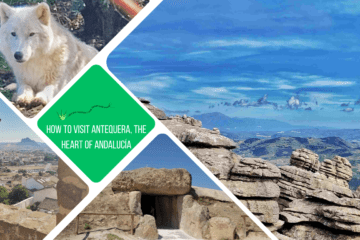
2 Comments
Rhea Williams · 09/11/2022 at 3:35 am
Thank you for this. You did all the bits we were too tired to do, after a day of walking around. Great to read about everything. Thank you.
Cassie · 09/11/2022 at 3:40 am
pleasure – thanks for reading!